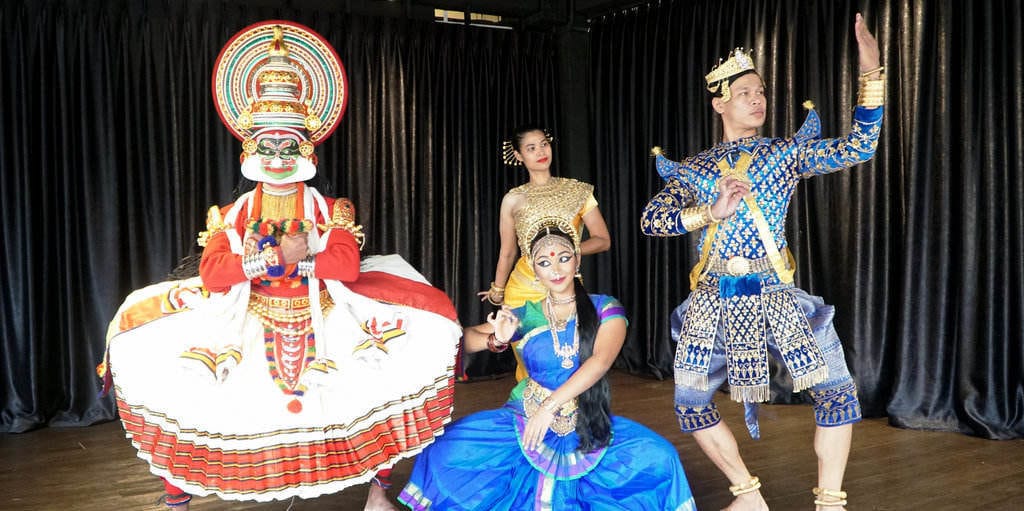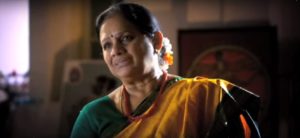Arts
Indian, Cambodian Dance Forms to Bring Alive Arjuna’s Brihannala in Singapore

(From left) Kalamandalam Biju as Keechaka, Nam Narim as Urvashi, Sor Sophal as Arjuna, and and Malini Bhaskar (front) as Brihannala in a scene from the production.
The dance drama, Brihannala - Arjuna’s Disguise, has been created by Singapore's Bhaskar Arts Academy and Amrita Performing Arts, Cambodia.
There are so many little stories in Mahabharata, says Santha Bhaskar. Bhaskar is talking about the upcoming dance drama, Brihannala – Arjuna’s Disguise, that is set to premiere on Nov. 5 in Singapore.
Brihannala is the tale of the Pandavas’ thirteenth year in the Virata kingdom where all of them go under a disguise. Arjun, due to the curse of the apsara Urvashi who was insulted when he refused her amorous advances, had to become the eunuch Brihannala who taught dance to the royal family. Urvashi’s curse was limited to one year because of his father Indra’s intervention, and the end of the curse coincided with a confrontation of the Pandavas with Kauravas.
“Brihannala is one of those stories that hasn’t been paid enough attention to as a dance drama. The episode that is usually depicted in most dance dramas is Draupadi’s vastraapaharanam,” Bhaskar, the 78-year-old artistic director and lead choreographer of Bhaskar’s Arts Academy, Singapore, tells Little India.

Santha Bhaskar
“This particular episode of Mahabharata is also very relevant today in the Singaporean society,” added Bhaskar. “The question of the third gender, the idea of how we all have male and female elements inside of us, how we can be both and neither at once — and what we identify with is very topical for the Singaporean society. While I have been thinking about this story for a while, now is when I feel the time is ripe for the production.”
Malini Bhaskar, the lead dancer, will portray the role of Brihannala while Cambodian dancer Sor Sophal will play Arjuna in his male form. The production is unusual in not only the choice of the episodes to tell, but also in collaborating different dance forms to make it come alive. The production will use vocabularies of Bharatnatyam, Cambodian traditional dance, and Kathakali for storytelling.
“It is quite a happy marriage,” says Bhaskar. The union will be seen in the production’s music as well, which features instruments such as mridangam as well as Cambodian drums.
“The Cambodian music is kind of woven into our music,” says Ghanavenothan Retnam, a flutist in the production, in a video posted on YouTube. The music for the production is composed by renowned flutist BV Balasai.
The production will explore similarities in the dance aesthetics of India and Cambodia in the form of a dance dialogue. “There is a thread connecting both the cultures. You can see the flavor of Indian classical dance in their movement and hand gestures,” Bhaskar explains.
The difference between the forms was where the fusion began, says the lead dancer, Malini, who happens to be the granddaughter of Santha. “We are so used to high energy, fast paced dance movements whereas the Cambodian dance is slow, controlled. It is a challenge to make that shift,” she adds.
Dancer Priya from their academy concurs in a video posted on YouTube: “The body structure, the way they move their legs, the counting we have to do with the music is very different from Bharatnatyam. We all had to help each other.”
So why was the gentler Cambodian dance chosen for Arjun’s male form? “The Cambodian dance has different techniques for male and female dancers,” explains Bhaskar. “It is not like Bharatnatyam where the same technique is taught to both male and female dancers. So the body language of a male Cambodian dancer would be on different from that of a female dancer. The dancer for Arjun would be strong and vigorous as opposed to a delicate performer for Urvashi.”
The role of Keechaka, the army commander of the Matsya kingdom who lusts after Draupadi, will be played by Kathakali dancer Kalamandalam Biju. Incidentally, the Kathakali wing of their academy is the only Kathakali troupe based outside of India, says Bhaskar.

Sor Sophal (Arjuna) and Malini Bhaskar (Brihannala) rehearsing for the production.
The Cambodian dance sections have been choreographed by Nam Narim from Amrita Performing Arts at Phnom Penh. The dancers from both the academies met at a dance festival in Thailand last year. They subsequently held multiple meetings over the selection of scenes before going ahead with the choreography.
The choreography that seemed to produce the most excitement in this collaborative production is the culminative warrior dance of Brihannala, which features elements of Cambodian, Kathakali, Bharatnatyam and even contemporary forms.
The school, that is well versed in putting up productions on the Ramayana, is attempting scenes from the Mahabharata for the first time now. “The only Mahabharata production we had ever done was on Shakuntala. We had never tackled Pandava and Kaurava scenes,” admits Bhaskar, who was awarded the Cultural Medallion in Singapore for her work in the field.
Bhaskar’s contributions to dance are evident from the fact that she was featured on the Singapore postal stamp in 1968. The stamp, which shows her in a pink and blue Bharatnatyam costume, was launched to promote racial harmony, three years after Singapore declared independence from the Federation of Malaya. It was part of a series of stamps titled Masks and Dance Definitives, which included traditional performance arts of the Chinese, Indian and Malay cultures.
Bhaskar’s Arts Academy, one of the oldest schools of Bharatnatyam in Singapore, goes back to 1952. It was established by India-born Singapore-based dancer KP Bhaskar. His marriage to Santha Bhaskar, a Bharatnatyam dancer from Kerala training under acclaimed guru Kuttalam Ganesham Pillai, brought her onboard the school. With her training in Kathakali under renowned dancer Guru Kunchukurup, and learning of newer forms over the years in Singapore, Santha believes her body has adapted to various styles of dance. “Art depends on its geographical conditions,” she says. For art to progress, it can’t be static and it has to interact with the world it is in.”
(Brihannala – Arjuna’s Disguise will be performed at 8 pm on Nov. 5 at Esplanade Theatre Studio, Singapore)



